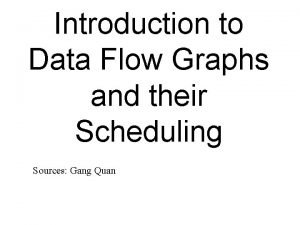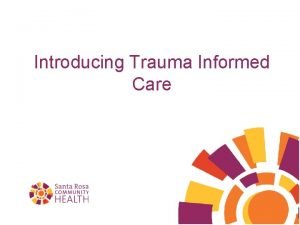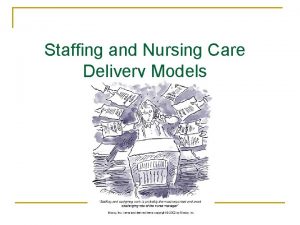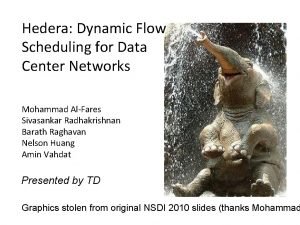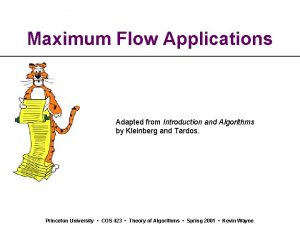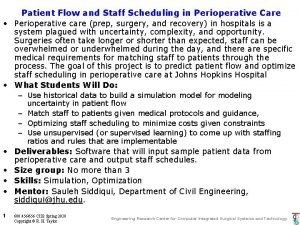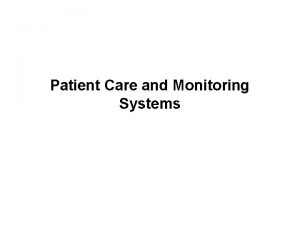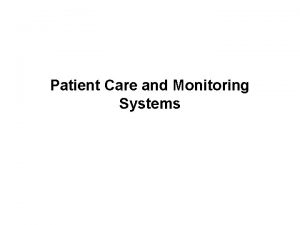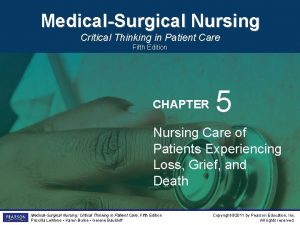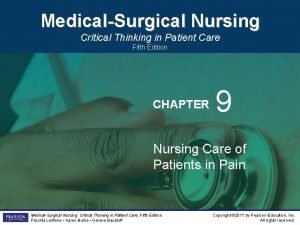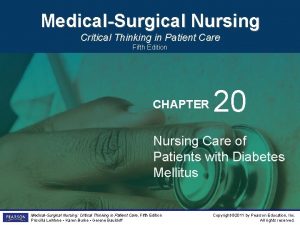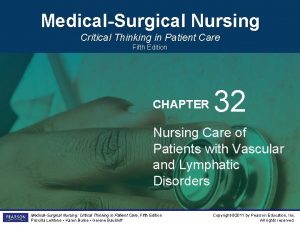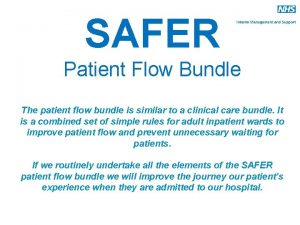Patient Flow and Staff Scheduling in MedicalSurgical Care











- Slides: 11

Patient Flow and Staff Scheduling in Medical/Surgical Care Members: Sara Cronin, Evelyn Yeh Mentor: Dr. Sauleh Siddiqui

Project Overview - Use historical data to create a model of patient flow in a medical/surgical unit - Create simulated patients and track flow in and out of unit and keep track of corresponding nursing need - Improve nurse scheduling - Test results of incremental changes in nursing levels based on patient census - Develop a program that outputs an optimized nurse schedule based on predicted patient movement

Updated Deliverables Minimum Completed ● ● Develop an algorithm to predict patient acuity Build a simulation for patient flow that utilizes historical data Expected ● ● Create an optimization algorithm for staff scheduling Integrate the algorithm with the simulation and output optimized staff schedules from simulation output Develop a patient census model from the simulation that can output an hourly projected patient census for the unit - In progress Develop a program that can convert the patient census to staffing requirements- In progress ● ● Maximum ● ● ● Make simulation adaptable to account for various hospital systems and room setups Verify simulation accuracy for other medical unit setups Create a model that incrementally increases or decreases staff based on the state of the unit

Completed Milestones - Segmented patient information based on relevant factors- season, day of the week, time of arrival, age of patient Created a prediction model based on patient attributes for use in simulation Developed simulation

Outputs

Future Milestones 4/17 - Alter simulation to match focus single unit and finish patient length of stay predictor based on time parameters 4/20 - Finalize census model 4/27 - Implement nurse matching to patient census 5/4 - Create program to analyze effects of proposed schedules 5/11 - Validate results


Dependencies Status Dependency Solution Progress Contingency Obtain data from HCGH Contact HCGH staff Completed Use older data from Dr. Siddiqui Choose machine learning/optimization software Find packages compatible with MATLAB Completed Use machine learning packages in Python Determine nurse matching and scheduling constraints Visit HCGH and speak to staff In progress visit scheduled for Tuesday 4/17 Contact through email

Responsibilities of each partner - - Sara: analyzing historical data to define and classify patients based on relevant features, creating probability distributions to sample from for the simulation Evelyn: developing and implementing the simulation structure Evelyn will test the accuracy of the simulation results and create the patient census model Sara will implement nurse matching and formulate the staffing interventions

Management Plan - Weekly meetings with Dr. Siddiqui on Fridays Code stored and shared on Github Our documentation is up to date on a Google Doc Weekly meetings (Sara & Evelyn) on Tuesday evenings to recap progress and confirm that documentation is up to date

Reading List and Bibliography Sauleh Siddiqui , Elizabeth Morse & Scott Levin (2017): Evaluating nurse staffing levels in perianesthesia care units using discrete event simulation, IISE Transactions on Healthcare Systems Engineering, DOI: 10. 1080/24725579. 2017. 1346729 Elina Kontio, Antti Airola, Tapio Pahikkala, Heljä Lundgren-Laine, Kristiina Junttila, Heikki Korvenranta, Tapio Salakoski, Sanna Salanterä, Predicting patient acuity from electronic patient records, Journal of Biomedical Informatics, Volume 51, 2014, Pages 35 -40, ISSN 1532 -0464, https: //doi. org/10. 1016/j. jbi. 2014. 001. Lee J, Maslove DM, Dubin JA (2015) Personalized Mortality Prediction Driven by Electronic Medical Data and a Patient Similarity Metric. PLo. S ONE 10(5): e 0127428. doi: 10. 1371/journal. Pone. 0127428 Rajeswari M, Amudhavel J, Pothula S, Dhavachelvan P. Directed Bee Colony Optimization Algorithm to Solve the Nurse Rostering Problem. Computational Intelligence and Neuroscience. 2017; 2017: 6563498. doi: 10. 1155/2017/6563498. Sir, M. Y. , Dundar, B. , Barker Steege, L. M. , & Pasupathy, K. S. (2015). Nurse–patient assignment models considering patient acuity metrics and nurses’ perceived workload doi: https: //doi. org/10. 1016/j. jbi. 2015. 04. 005
 Foxwoods dealer scheduling
Foxwoods dealer scheduling Job scheduling vs process scheduling
Job scheduling vs process scheduling Types of care primary secondary tertiary
Types of care primary secondary tertiary Patient 2 patient
Patient 2 patient Flow graph
Flow graph Trauma-informed care activities for staff
Trauma-informed care activities for staff Team nursing care delivery model
Team nursing care delivery model Patient safety and quality care movement
Patient safety and quality care movement Hedera: dynamic flow scheduling for data center networks
Hedera: dynamic flow scheduling for data center networks Airline scheduling max flow
Airline scheduling max flow Optimizing patient flow
Optimizing patient flow Patient flow
Patient flow




